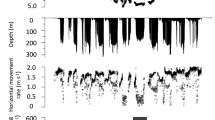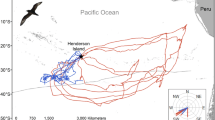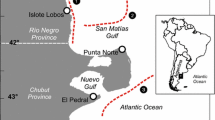Abstract
This study investigates the movements of Magellanic Penguins Spheniscus magellanicus breeding on Isla Martillo during the early chick-rearing period. Foraging paths were reconstructed using GPS loggers that registered the penguins′ geographic position, water temperature and depth at regular intervals. The relationship between penguins′ movements and search strategies, tide and tidal currents were assessed. Mean trip duration was on average 14.7 ± 6.9 h (33% overnight), and the maximum distance reached was 24 ± 10 km. All penguins studied foraged to the east of the colony. We identified three phases based on the sinuosity and speed of the trajectory: transit, central and return. Foraging effort was higher during the central phase, followed by the transit phase, and lower in the return phase. Foraging success, measured as the percentage of time at the bottom during each phase, was also highest during the central phase. In all birds studied, the central phase of the foraging trip took place during ebb tide, and birds travelled to the foraging areas with flow tide running in the same direction of displacement. Our study suggests that penguins take advantage of tidal currents to facilitate their movements to and from the main foraging area, thereby reducing the energy expended. Moreover, we suggest that piscivorous diving birds may enhance their catch rate during ebb tide when fish are more concentrated near the channel bed.






Similar content being viewed by others
References
Aldredge AL, Hamner WM (1980) Recurring aggregation of zooplankton by a tidal current. Estuarine coastal marine. Science 10:31–37
Antezana T (1999) Hydrographic features of Magellan and Fuegian inland passages and adjacent Subantarctic waters. Sci Mar 63:23–34
Boersma PD, Rebstock GA, Frere E, Moore SE (2009) Following the fish: penguins and productivity in the South Atlantic. Ecol Monogr 79(1):59–76
Bost CA, Georges JY, Guinet C, Cherel Y, Pütz K, Charassin JB, Handrich Y, Zorn T, Lage J, Le Maho Y (1997) Foraging habitat and food intake of satellite tracked king penguins during the austral summer at Crozet Archipelago. Mar Ecol Prog Ser 150:21–33
Bost CA, Jaeger A., Huin W, Koubbi P, Halsey LG, Hanuise N, Handrich Y (2008) Monitoring prey availability via data loggers deployed on seabirds: advances and present limitations. Fisheries for Global Welfare and Environment, 5th World Fisheries Congress 121–137
Cairns DK (1987) Seabirds as indicators of marine food supplies. Biol Oceanogr 5:261–271
Casarsa L (2005) Morfología y comportamiento de los cardúmenes de sardina fueguina (Sprattus fuegensis) en dos sectores característicos del Atlántico Sudoccidental. Tesis de Licenciatura Universidad de Mar del Plata pp 25
Charrassin JB, Bost CA (2001) Utilisation of the oceanic habitat by king penguins over the annual cycle. Mar Ecol Prog Ser 221:285–297
Charrassin JB, Le Maho Y, Bost CA (2002) Seasonal changes in the diving parameters of king penguins (Aptenodytes patagonicus). Mar Biol 141:581–589
Chen GT, Herman RL, Vincx M (1999) Meiofauna communities from the Straits of Magellan and the Beagle Channel. Scientia Marina 63(1):123–132
Chiaradia A, Ropert-Coudert Y, Healy M, Knott N (2005) Finding the balance: the effect of the position of external devices on little penguins. Polar Biosci 18:46–53
Cotté C, Simard Y (2005) Formation of dense krill patches under tidal forcing at whale feeding hot spots in the St. Lawrence estuary. Mar Ecol Prog Ser 288:199–210
Cotté C, Park YH, Guinet C, Bost CA (2007) Movements of foraging king penguins through marine mesoscale eddies. Proc R Soc B 274:2385–2391
Croxall JP, Prince PA (1980) Food, feeding ecology and ecological segregation of seabirds in South Georgia. Biol J Linn Soc 14:103–131
Culik B, Wilson RP, Bannasch R (1994) Underwater swimming at low energetic cost by Pygoscelid Penguins. J Exp Biol 197:65–78
Davoren GK, Montevecchi WA, Anderson JT (2003) Distributional patterns of a marine bird and its prey: habitat selection based on prey and conspecific behaviour. Mar Ecol Prog Ser 256:229–242
Fauchald P (1999) Foraging in a hierarchical patch system. Am Nat 153:603–613
Fauchald P, Tveraa T (2003) Using first-passage time in the analysis of area-restricted search and habitat selection. Ecology 84:282–288
Forward RB, Tankersley RA (2001) Selective tidal-stream transport of marine animals. In: Gibson RN, Barnes M, Atkinson RJA (eds) Oceanography and marine biology: an annual review, vol 39. Taylor and Francis, London, pp 305–353
Frere E, Gandini P, Lichtschein V (1996) Variación Latitudinal de la dieta del Pinguino de Magallanes (Spheniscus magellanicus) en la costa Patagonica, Argentina. Ornitol Neotrop 7:35–41
Frere E, Quintana F, Gandini P (2002) Diving behavior of the red-legged cormorant in southeastern Patagonia, Argentina. Condor 104:440–444
Fritz H, Saïd S, Weimerskirch H (2003) Scale-dependent hierarchical adjustments of movement patterns in a long range foraging seabird. Proc R Soc B 270:1143–1148
Gandini P, Frere E, Quintana F (2005) Feeding performance and foraging area of the red-legged cormorant. Waterbirds 28:41–45
Gibson RN (2003) Go with the flow: tidal migration in marine animals. Hydrobiologia 503:153–161
Grémillet D, Wilson RP, Gary Y, Storch S (1999) Three dimensional space utilization by a marine predator. Mar Ecol Prog Ser 183:263–273
Grémillet D, Kuntz G, Delbart F, Mellet M, Kato A, Robin JP, Chaillon PE, Gendner JP, Lorentsen SH, Le Maho Y (2004) Linking the foraging performance of a marine predator to local prey abundance. Funct Ecol 18:793–801
Hastie GD, Wilson B, Thompson PM (2003) Finescale habitat selection by coastal bottlenose dolphins: application of a new land-based video montage technique. Can J Zool 81:469–478
Hays GC, Luschi P, Papi F, del Seppia C, Marsh R (1999) Changes in behaviour during interesting period and postnesting migration for Asension Island green turtles. Mar Ecol Prog Ser 180:263–273
Hoffman W, Heinemann D, Wiens JA (1981) The ecology of seabird feeding flocks in Alaska. Auk 98:437–456
Holm KJ, Burger AE (2002) Foraging behavior and resource partitioning by diving birds during winter in areas of strong tidal currents. Waterbirds 25:312–325
Hunt GL Jr (1997) Physics, zooplankton, and the distribution of least auklets in the Bering Sea—a review. ICES J Mar Sci 54:600–607
Hunt GL Jr, Mehlum F, Russell RW, Irons D, Decker MB, Becker PH (1999) Physical processes, prey abundance, and the foraging ecology of seabirds. In: Adams NJ, Slotow RH (eds) Proceedings of 22nd International Ornithological Congress, Durban. pp. 2040–2056
Hunt GL Jr, Russell RW, Coyle KO, Weingartner T (1998) Comparative foraging ecology of planktivorous auklets in relation to ocean physics and prey availability. Mar Ecol Prog Ser 167:241–259
Ichii T, Bengtson JL, Boveng Y, Takao Y, Jansen JK, Lisa M, Raring H, Cameron MF, Okamura H, Hayashi T, Naganobu M (2007) Provisioning strategies of Antarctic fur seals and chinstrap penguins produce different responses to distribution of common prey and habitat. Mar Ecol Progr Ser 344:277–297
Laidre KL, Heide-Jorgensen MP, Logdson ML, Hobbs RC, Heagerty P, Dietz R, Jorgensen OA, Treble MA (2004) Seasonal narwhal habitat associations in the high Arctic. Mar Biol 145:821–831
Lescroël A, Bost CA (2005) Foraging under contrasted oceanographic conditions: the Gentoo Penguin at Kerguelen Archipelago. Mar Ecol Progr Ser 302:245–261
Luna-Jorquera G, Culik BM (2000) Metabolic rates of swimming Humboldt Penguins. Mar Ecol Prog Ser 203:301–309
Mattern T, Ellenberg U, Houston DM, Davis LS (2007) Consistent foraging routes and benthic foraging behaviour in yellow-eyed penguins. Mar Ecol Prog Ser 343:295–306
Piatt JF, Harding AMA, Shultz M, Speckman SG, Van Pelt TI, Drew GS, Kettle AB (2007) Seabirds as indicators of marine food supplies: Cairns revisited. Mar Ecol Prog Ser 352:221–304
Pinaud D, Weimerskirch H (2005) Scale-dependent habitat use in a long-ranging central place predator. J Anim Ecol 74:852–863
Pinaud D, Weimerskirch H (2007) At sea distribution and scale-dependent foraging behaviour of petrels and albatrosses: a comparative study. J Anim Ecol 76:9–19
Pütz K, Ropert-Coudert Y, Charrassin JB, Wilson RP (1999) Foraging areas of King penguins Aptenodytes patagonicus breeding at Possession Island, southern Indian Ocean. Mar Ornithol 27:77–84
Pütz K, Smith JG, Ingham RJ, Lüthi BH (2003) Satellite tracking of male Rockhopper Penguins Eudyptes chrysocome during the incubation period at the Falkland Islands. J Avian Biol 34:139–144
Raya Rey A, Trathan P, Pütz K, Schiavini A (2007) Effect of oceanographic conditions on the winter dispersion of Eudyptes chrysocome chrysocome. Mar Ecol Prog Ser 330:285–295
Ream RR, Sterling JT, Loughlin TR (2005) Oceanographic features related to northern fur seal migratory movements. Deep Sea Res II 52:823–843
Ryan PG, Petersen SL, Peters G, Gremillet D (2004) Field testing GPS loggers on marine predators: effects of precision, resolution and sampling rate on foraging tracks of African Penguins. Mar Biol 145:215–223
Sabatini ME, Giménez J, Rocco V (2001) Características del zooplancton del área costera de la plataforma patagónica austral (Argentina). Bol Inst Esp Oceanogr 17:245–254
Sanchez RP, Remeslo A, Madirolas A, de Ciechomski JD (1995) Distribution and abundance of post-larvae and juveniles of the Patagonian sprat, Sprattus fuegensis, and related oceanographic conditions. Fish Res 23:47–81
Schiavini A, Raya Rey A (2004) Long days, long trips: foraging ecology of female rockhopper penguins Eudyptes chrysocome chrysocome at Tierra del Fuego. Mar Ecol Prog Ser 275:251–262
Schiavini A, Yorio P, Gandini P, Raya Rey A, Boersma D (2005) Los pingüinos de las costas argentinas: estado poblacional y conservación. El Hornero 20:5–23
Scolaro JA, Wilson RP, Laurenti S, Kierspel M, Gallelli H, Upton JA (1999) Feeding preferences of the Magellanic Penguin over its breeding range in Argentina. Waterbirds 22:104–110
Stephens DW, Krebs JR (1986) Foraging theory. Princeton University Press, Princeton, New Jersey, USA
Tollit DJ, Black AD, Thompson PM, Mackay A, Corpe HM, Wilson B, Van Parijs SM, Grellier K, Parlane S (1998) Variations in harbour seal Phoca vitulina diet and dive depths in relation to foraging habitat. J Zool 244:209–222
Weimerskirch H, Wilson PR, Lys P (1997) Activity pattern of foraging in the wandering albatross: a marine predator with two modes of prey searching. Mar Ecol Prog Ser 151:245–254
Weimerskirch H, Pinaud D, PawlowskI F, Bost CA (2007) Does prey capture induce area-restricted search? A fine detail study using GPS in a marine predator, the wandering albatross. Am Nat 170:734–743
Williams TD, Briggs DR, Croxall JP, Naito Y, Kato A (1992) Diving pattern and performance in relation to foraging ecology in the gentoo penguin, Pygoscelis papua. J Zool Lon 227:211–230
Wilson RP, Pütz K, Peters G, Culik BM, Scolaro JA, Charrassin J-B, Ropert-Coudert Y (1997) Long-term attachment of transmitting and recording devices to penguins and others seabirds. Wildl Soc Bull 25:101–106
Wilson RP, Locca R, Scolaro JA, Laurenti S, Upton J, Gallelli H, Frere E, Gandini P (2001) Magellanic penguins (Spheniscus magellanicus) commuting through San Julian Bay; do current trends induce tidal tactics? J Avian Biol 32:83–89
Wilson RP, Kreye J, Lucke K, Urquhart H (2004) Antennae on transmitters on penguins: balancing energy budgets on the high wire. J Exp Biol 207:2649–2662
Wilson RP, Scolaro JA, Grémillet D, Kierspel MAM, Laurenti S, Upton J, Gallelli H, Quintana F, Frere E, Müller G, Thor Straten M, Zimmer I (2005) How do Magellanic penguins cope with variability in their access to prey? Ecol Monogr 75:379–401
Zamon JE (2002) Tidal changes in copepod abundance and maintenance of a summer Coscinodiscus bloom in the Southern San Juan Channel, San Juan Islands, USA. Mar Ecol Prog Ser 226:193–210
Zamon JE (2003) Mixed species aggregations feeding upon herring and sandlance schools in a near shore archipelago depend on flooding tidal currents. Mar Ecol Prog Ser 261:243–255
Acknowledgments
This research was made possible through the support of the Consejo Nacional de Investigaciones Científicas y Técnicas (CONICET) and the financial support to the Antarctic Research Trust by the Vontobel-Stiftung, Switzerland, Proyecto Prevención Prevención de la contaminación costera y Gestión de la biodiversidad Marina, donación FMAN/BIRF Nº28.385, and the Wildlife Conservation Society. Special thanks to Dr. Carlos Mazio from the Servicio de Hidrografía Naval, Argentina, who provided the tide and tidal current data. Also, thanks are due to Lesley Baxter for language editing. We would like to thank Dr Frere and one anonymous referee for their comments that improved the manuscript. This study was approved by the National Council of Scientific Research and the Natural Resources Agency of the province of Tierra del Fuego, and complied with the legal requirements in Argentina.
Author information
Authors and Affiliations
Corresponding author
Additional information
Communicated by P. H. Becker.
Rights and permissions
About this article
Cite this article
Raya Rey, A., Bost, CA., Schiavini, A. et al. Foraging movements of Magellanic Penguins Spheniscus magellanicus in the Beagle Channel, Argentina, related to tide and tidal currents. J Ornithol 151, 933–943 (2010). https://doi.org/10.1007/s10336-010-0531-y
Received:
Revised:
Accepted:
Published:
Issue Date:
DOI: https://doi.org/10.1007/s10336-010-0531-y




